Remote work, EU labour markets and wage inequality
More remote working in the wake of the pandemic could exacerbate wage inequality, with young workers, women and the low educated potentially losing ou

This Blog was produced within the project “Future of Work and Inclusive Growth in Europe“, with the financial support of the Mastercard Center for Inclusive Growth.
On the eve of the COVID-19 pandemic, in March 2020, unemployment in the European Union stood at the historic low rate of 6.3%. Due to the pandemic, it then began to rise, reaching 7.7% in September 2020. While unemployment has declined somewhat since then, signalling that the EU is on the path to labour market recovery, the nature of some jobs has changed with major implications for EU employment.
The pandemic has particularly impacted jobs that cannot be done remotely. Dingel and Neiman (2020) developed a remote work score for different types of occupation (Figure 1). Occupations with a score close to zero cannot be done remotely, while most tasks in occupations with scores close to 1 can be done remotely without significant problems and in line with social-distancing restrictions.
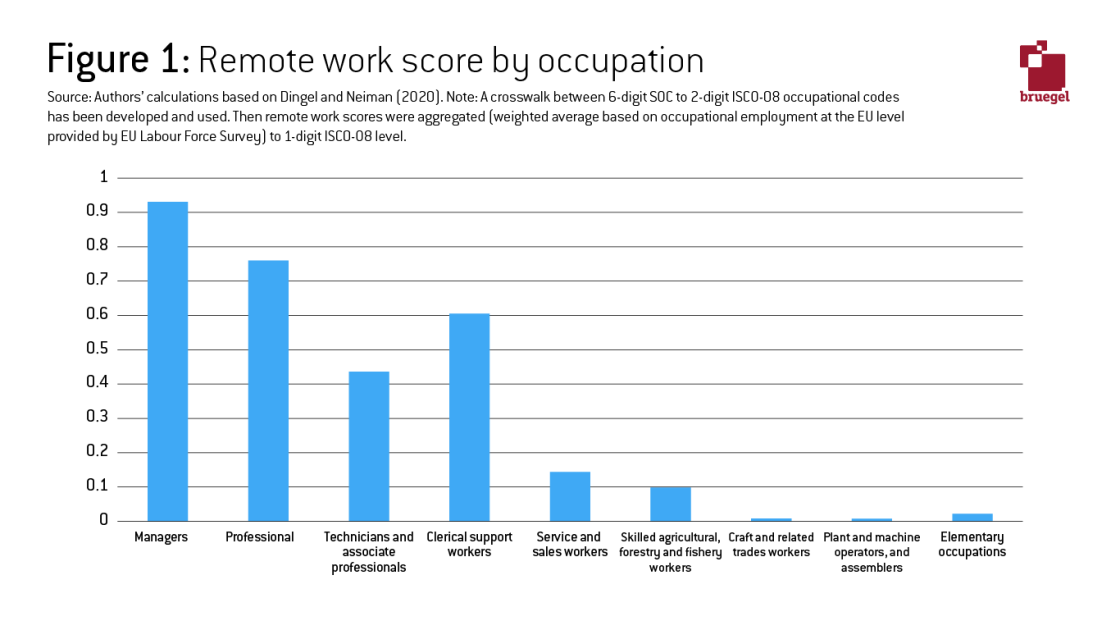
Occupations such as cleaning and food preparation (which are classified as elementary), plant operation, assembly and craft-related trades cannot easily be done remotely and therefore have been severely impacted by the pandemic. In contrast, high-skilled managerial jobs are relatively easy to adjust to social-distancing restrictions.
Figure 2 plots remote work scores relative to EU average annual wages for each occupation type for 2019, before the pandemic impacted the EU labour market. Low-paid jobs are the least possible to be done remotely. The remote work score increases as for occupations types with higher average wages in the EU.
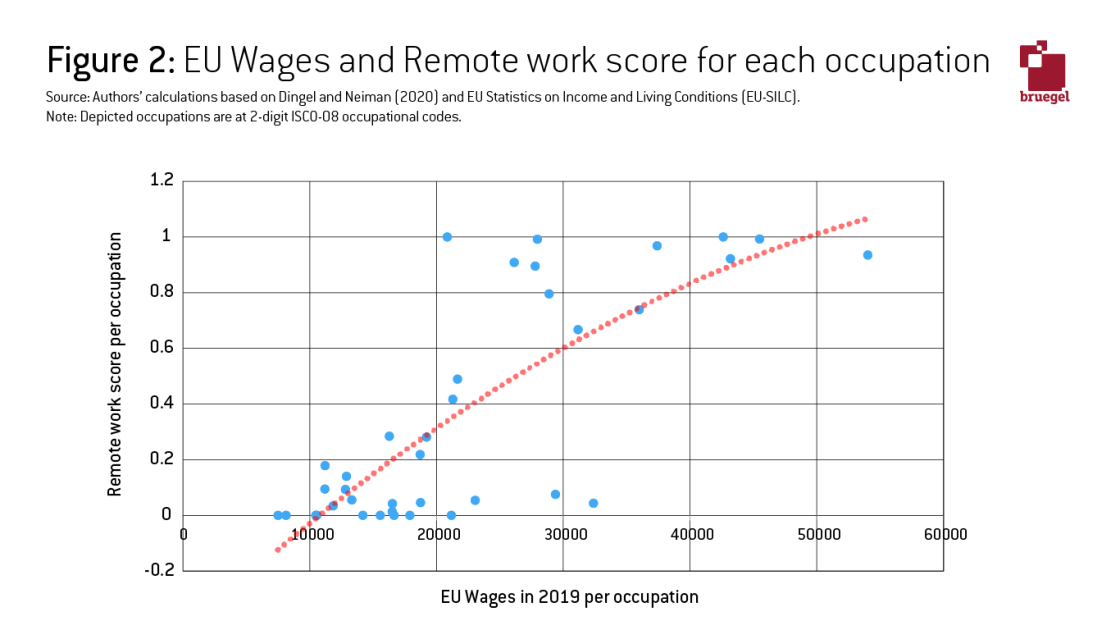
Evidence suggests that the increase in the prevalence of remote work will persist in the long-run post-pandemic. That may suggest that some low-paid/low-skilled jobs are at risk because when some jobs are increasingly done remotely, other jobs linked to them become less viable. If, for example, office time or business travel drastically reduce, so will demand for office cleaning, travel services and food preparation. This could result in downward pressure on the wages of these occupations and higher unemployment rates for low-paid jobs.
Over the next decade, 4.3 million jobs could disappear in customer service and food service, compared to before the pandemic, according to McKinsey (in an analysis covering eight large countries, including France, Germany and Spain). The increase in transportation and last-mile delivery jobs (an additional 760,000 jobs) will only partially offset those losses. McKinsey also estimated that business travel will not return to its pre-pandemic level and will drop by 20% in the post-pandemic era (a Bloomberg survey pointed in the same direction). This could significantly reduce employment in commercial aviation and airport services, and in hospitality and food service.
The implication is that a safety net should be prioritised, with a mix of policies for those who are most affected or excluded from the ongoing COVID-19-induced transformation of work, a major ingredient of which is the accelerating digitalisation of the economy. The distributional effects of such a transformation of work also raise concerns. Remote work is not neutral with respect to the wages of different demographic groups and groups with different educational attainment, or across EU countries.
To illustrate this, we first consider how remote work is related to wage inequality given the EU occupational structure before the pandemic, and then we refer to preliminary findings and relevant data on the impact of the pandemic on these groups.
We begin by calculating for each occupation type the EU wage gap between old and young workers as a percentage of the average occupational wage in EU labour markets in 2019 (our measure of the age wage gap). We see that in general occupation types more amenable to remote work are on average those with greater age-related wage gaps. In some managerial and professional occupation types, the age wage gap exceeds 50% (eg hospitality, administrative and commercial managers, science, engineering, legal and ICT professionals), while in occupations with low remote scores, such as farming and fishing, or in street sales and services, the age wage gap is much smaller or even inverted (the young earn more than older workers on average in some of these types of jobs).
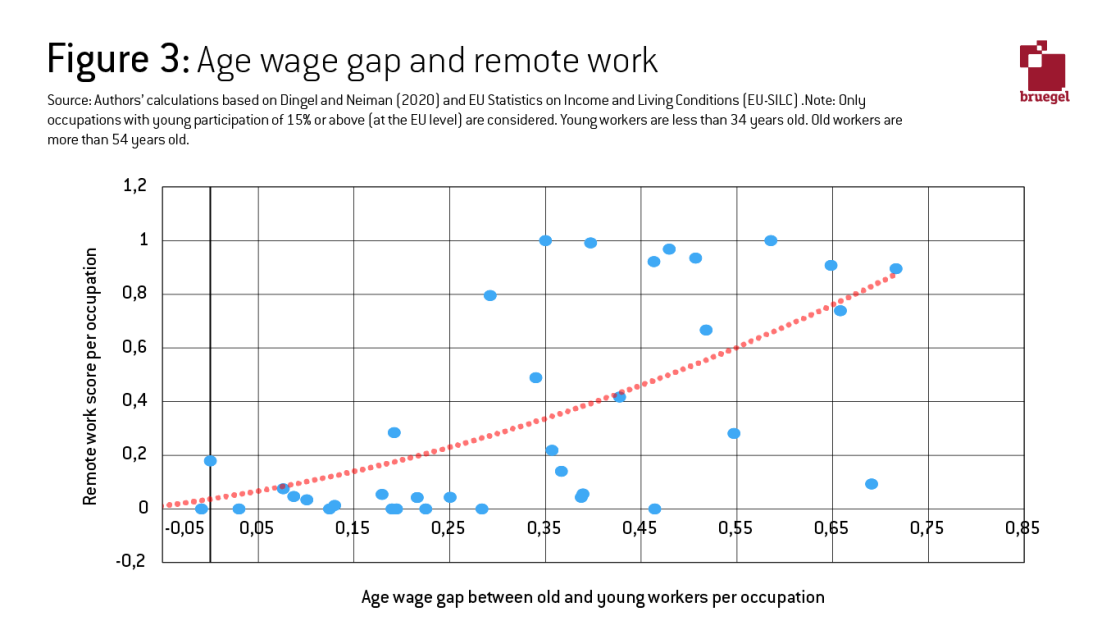
It is unsurprising that evidence on the short-term impact of the pandemic shows that youth unemployment increased during the second quarter of 2020, while unemployment remained almost unchanged compared to the year before for the older cohort. Young people, especially in low-paid occupations with limited opportunities for remote work, were particularly vulnerable.
We now consider the EU average wage gap between men and women in 2019 as a percentage of the EU average occupational wage (Figure 4). Comparing Figure 1 and Figure 4, we see that there seems to be a non-linear relationship between remote work scores and the gender wage gap. In general, in occupations with relatively low remote scores, we observe significant variation in terms of the gender wage gap. For example, in elementary occupations, the wage gap is small (only 8.2%) in food preparation services, but appears to be high for cleaners and helpers (42%). The largest gender wage gap at EU level is not in managerial jobs that can easily be done remotely, but in the category of service and sales workers (with personal and protective service workers and sales workers being the frontrunners in gender wage inequality with wage gaps of 54% and 47%, respectively), for which remote work scores are on average much lower. Service and sales is also the category with the highest number of female workers in the EU (more than 22% of women in the EU labour force were working in this occupational category in 2019).
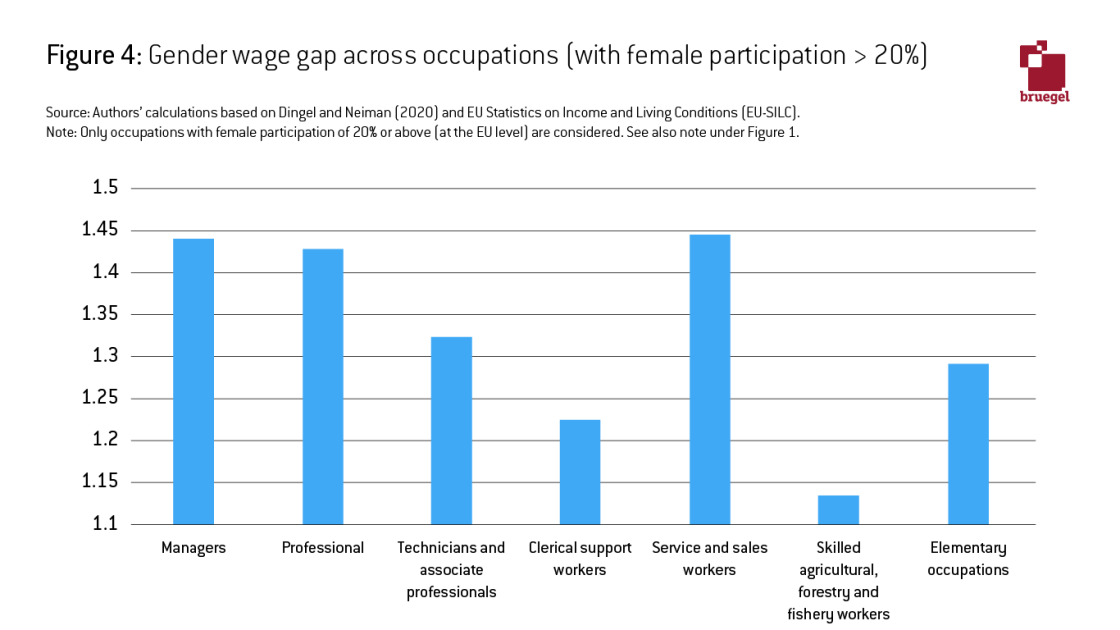
It is not easy to reach a safe conclusion about the exact relationship between gender inequality and remote work by only looking at the occupational structure before the pandemic, because of the non-linearities involved.
Looking instead at the pandemic period, McKinsey found that COVID-19 has disproportionately affected women and in particular young mothers with children. They have either moved out of the workforce or have stepped back from their careers as they faced greater obstacles to working from home. This finding is associated with reasons that go beyond the occupational ability to work remotely, including women’s contributions to households and childcare that can interfere with their work from home.
Educational attainment is another important factor to consider. The wage gap between low- and high-educated people is on average increasing in occupations more suited to remote work. Evidence from the pandemic period suggests that people with lower educational levels are less able to work remotely than people with tertiary degrees. If indeed low remote-work-score jobs are at risk, the returns to education could increase, suggesting that wage (and income) inequality across groups with different educational attainment will rise.
Last but not least, we can also look from a country perspective. The share of work that can be done remotely varies across EU countries. It appears strongly correlated with the GDP per capita in each country (2019; Figure 5). On average, the EU’s remote work score is lower than those of the United States and United Kingdom.
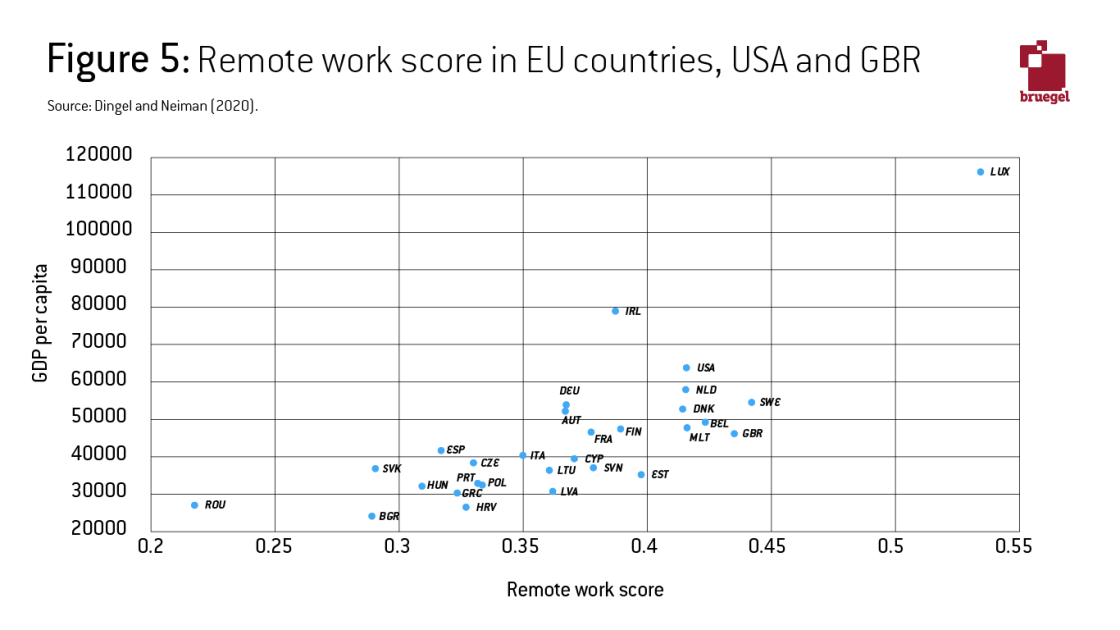
This implies that each country will experience a different intensity of transformation of work as each country relies to a different extent on tools that enable productive remote work. In the post-pandemic era, this may have serious implications for the labour productivity of each country and could lead to increasing divergence in labour output in different EU countries.
If there is to be a hybrid work framework in which remote working is an important element, it is vital to consider the implications for wage inequality so safeguards can be put in place and the future growth path is inclusive.
Recommended citation:
Petropoulos, G. and T.Schraepen (2021) ‘Remote work, EU labour markets and wage inequality’, Bruegel Blog, 14 September



